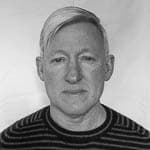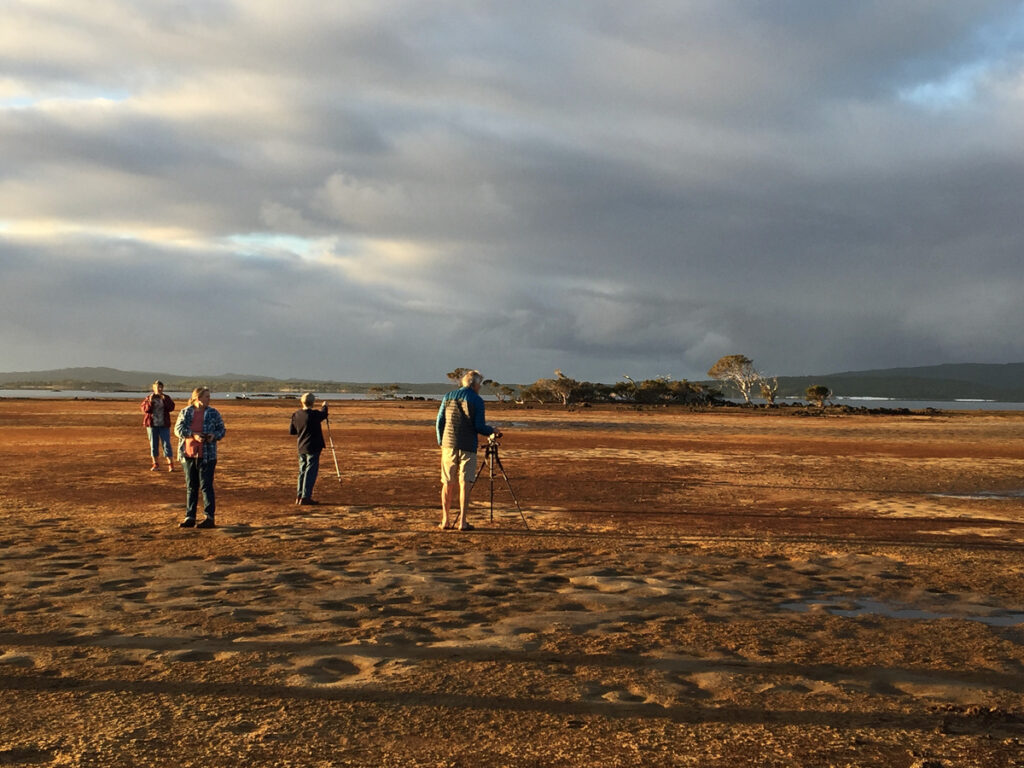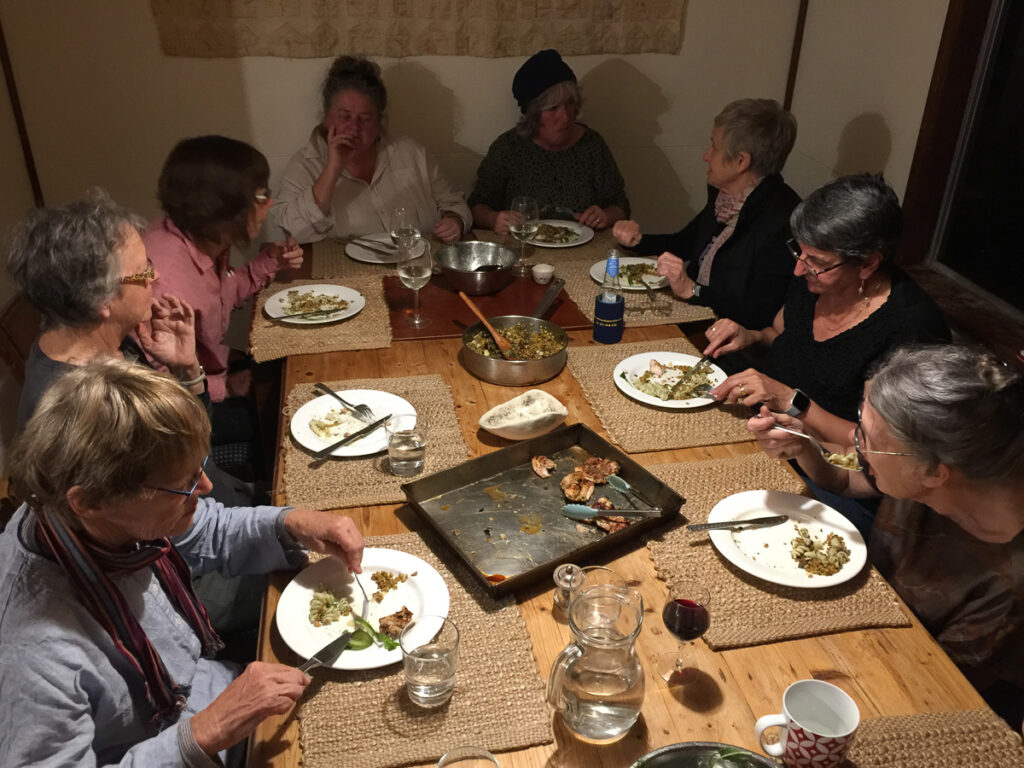Gregory Pryor documents the bush encounters of a West Australian collective that is finding ways of sharing knowledge outside the formal academy.
Making a commitment to go bush with a group of people is not a straightforward decision. For the members of the art collective, We Must Get Together Some Time (WMGTST), there is a wide range of responsibilities that might prevent them undertaking such an experience. So, when they finally arrive at their destination, an important process of shedding has been set in motion, and this can continue for some time afterwards, as the complexity and confusion of arriving into a powerful and ancient landscape demands one’s complete attention.
The juxtaposition of this often-volatile environment with the familiar cladding of our everyday lives can be extreme. A roof overhead, a comfortable bed, well-stocked pantry and refrigerator, the smartphone and computer, the all-pervasive presence of connectivity, the provision of water and energy sources to provide warmth and cooling, a functioning kitchen and warm water to bathe oneself; all these elements need to be cast off to allow a new level of experience to manifest in the bush.
This process corresponds to the shedding that is such a distinctive feature of so much of the Australian biota, especially the decortication of eucalyptus bark. This shedding is not the comparatively neat and synchronised display that signals a change of season in the northern hemisphere, when phytochromes shift their hue from cool to warm before eventually decaying and falling to earth in their host leaves. The members of WMGTST arrive at camp with nascent ideas below the surface of their everyday lives, like the epicormic buds studded underneath the thick bark of the eucalyptus, only emerging when the bark is shed after fire. This is often why the lighting of the first communal fire is so significant. These buds emerge at different times for different members, but over the course of the camp, often appear through a mutual experience of shedding and an awareness that other ideas are emerging or even flourishing once the routines and impediments of contemporary life are ablated:
Bark was thick, tough, and it shed as it burned like the ablation plate of a descending spacecraft.1.Pyne, S. (1998). Burning Bush : A fire history of Australia. University of Washington Press. p.20
Setting up a tent or placing your travel bag on the earth is a simple, yet powerful gesture of arrival. This place where you have come to meet is immediately being shaped by the mutual decision of others to do the same. Before a fire is lit, a shelter constructed or a meal is shared, all present are momentarily naked in unfamiliar territory, so the activity of putting these things in place is an intimate decision to make a site familiar and sustaining. Making camp is about making a shared decision to be protected. It declares to the bush, in the gentlest way possible, that you have come together peacefully and respectfully to learn and share what is learnt. It is not just knowledge and experience that is shared, but also fears and ignorance, so that unfamiliarity with a site can be addressed as a collective over the duration of the camp.
Having set up camp, and the last vestiges of familiar life are shed, there is a shift now towards dwelling at the temporary site. The security provided through collective dwelling in the bush encourages more investigative and exploratory movement from camp through walking, as the participants radiate out from the campfire to find their own contact points of experience. Each carry their own tools with them, before returning to the group endowed with something new in their lives. Despite the diverse backgrounds and disciplines of the members, all possess a desire to engage with the encyclopaedic materiality that the bush provides.
This multi-sensory negotiation of what stands in the bush and what has been shed often bypasses the more dominant role vision can play in shaping our experience of the world. WMGTST do not overly foreground an engagement with the art-historical conventions of landscape, the sublime, the view or the picturesque, but are more focused on an engagement with the land through the more pervasive senses of touch, smell, hearing, and taste. Sight is often unconsciously edited through our own personal background and experience, or used as an inquisitorial device, rather than a summative one. The eyes identify the material components that make up the broader landscape, such as plants, soil, and animals, but it is often the body—through the other senses that slow down the process of being in a place:
More importantly, because vision engages knowledge and memory, it shifts rapidly, even imperceptibly, between specific moments and places, present and past experiences; the way one sees a landscape now is deeply affected by the memory of seeing it in the past or by prior knowledge brought by the viewer even before the first encounter with that landscape. 2.Harris, D., & Fairchild Ruggles, D. (Eds.). (2007). Sites unseen : landscape and vision. University of Pittsburgh Press. pp. 12-13
In this respect, the complexity and speed of vision may render it a less appropriate sense for the deep time of the Australian bush. The more meditative rhythm of dwelling and walking and the slow gathering of materials that exude vital and hidden juices, are more aligned to the geological and climatic forces that have shaped these lands over millennia. WMGTST are also respectfully aware that this approach is necessary given the sensitive care and knowledge embedded in country by the Aboriginal custodians over thousands of years. One of the consistent threads running through this exhibition is that time is embraced as a medium of choice.
Artist’s camps in the Australian bush have contributed much to the settler art historical conception of place, most notably through the Heidelberg School and the work of artists such as Frederick McCubbin, Arthur Streeton, Tom Roberts and Clara Southern.
These artists are so often framed as proponents of a type of “Australian Impressionism,” based on the European art movement that emerged from an interest in painting en plein air in the late nineteenth century. Whilst endeavouring to express some of the distinctive environmental qualities of the Australian bush, the Heidelberg school artists were still very much shaped in their endeavours by foreign movements in art and thinking prevalent at the time:
Painting technique itself had to convey the direct and immediate, since the experience of modernity and the authentic personal “impression” were embodied in painting’s very materiality. 3.Callen, A. (2015). The work of art : plein air painting and artistic identity in nineteenth-century France. Reaktion Books, Limited. pp. 211-212
Rather than a direct and immediate response to landscape through the materiality of a medium, the members of WMGTST are more inclined to reside in their response through a deeper immersion in materiality of place. To emphasise this difference, the fleeting “impression” of light so favoured by the Heidelberg school artists contrasts with the impressions made of the collective member’s knees by Nien Schwarz. A pancake of clay is sprinkled with significant geological material personally selected by the subject, before being applied like a poultice and gently pressed around the joint. The resulting form is inverted and fired to form a bowl that carries a multitude of associations, but in this context, it seems to suggest equal parts nourishment and offering, and a fitting gesture of terrestrial supplication.
Seven large-format photographs of Yosemite Valley taken by Carleton Watkins were purchased by the National Gallery of Victoria in 1871 and with their arrival in Australia came an awareness of the role they played in Yosemite being declared a National Park. Ecclestone Du Faur, the de facto director of the Art Gallery of NSW between 1876 and 1892, saw an opportunity to employ photographers to fulfil a similar role in the Blue Mountains and was chiefly responsible for the creation of the Ku-ring-gai Chase National Park. 4.Bonyhady, T. (2010). Artist’s with axes. In Johnson, S. Landscapes (Ser. Themes in environmental history, v. 2). (pp. 78-96). White Horse Press. The irony of this endeavour was the fact that Du Faur took a team of artists and photographers into the Grose valley, where they cleared substantial areas of bush to ‘create’ the type of views they felt would garner attention for the valley to equal the status of Yosemite as a gazetted state park:
Du Faur’s solution was to employ a work gang not only to re-open the old track into the valley but also to clear “views to be taken by pencil and camera” at sites which he selected. The first artist to arrive was the Tasmanian landscape painter, W.C. Piguenit, who seems to have worked happily on his own without engaging in further clearing. But when most of the rest of the party arrived ten days later, they spent the entire afternoon creating new views at their second camp at the junction of the Grose River and Govett’s Leap Creek. Three days later Du Faur and five companions renewed their axe-work closer to Govett’s Leap Falls. 5. Ibid.
The landscape surgery undertaken on these artist’s camps and the cumbersome large format glass plates that needed five men to carry into the valley for the photographer Joseph Bischoff, dramatically contrasts with the delicate and low impact anthotypes or cyanotypes utilised by WMGTST member Perdita Phillips in her response to the bush.
A gentle and respectful approach permeates the ethos of WMGTST and continues a tradition of artist’s camps in Western Australia that have been associated with Edith Cowan University (ECU) over more than three decades. The textile artist and lecturer Elsje King ran many camps for textile students which extolled a similar approach, engendering many of the graduates with a deeper understanding of making work in response to the landscape in Western Australia (WA). Nalda Searles and Nien Schwarz continued this tradition, and both have been influential figures behind the formation of WMGTST. Annette Nykiel, the current coordinator of WMGTST, completed her PHD with Nien Schwarz at ECU and their jointly curated exhibition field working slow making at Spectrum Project Space in 2016 provided a template for the current exhibition.
Judith Dinham and Glenn Phillips initiated a master’s course at ECU in 1996 titled Landscape and You, which became a twelve-part television series produced by WMGTST member George Karpathakis in the late 1990s. Landscape and You combined a truly diverse range of voices in relation to the landscape of WA, something that WMGTST has also been keen to continue, with artists, academics, scientists, writers, filmmakers, photographers, and slow-makers all making an important contribution to our understanding of an ancient and threatened land. This link to an academic institution with a strong reputation for teaching and learning is important and several unique workshops by WMGTST members are an important initiative that runs parallel to the exhibition.
With the slow and concerning erosion of creative arts programs in universities nationally, WMGTST is filling an important gap in how creative practitioners respond to and elevate awareness of the threatened landscapes of WA. The condensing of staffing, resources and curriculums has meant that art school camps, once a mainstay of most art courses offered in Australia have been cut from programs for being too expensive and risky to run. This collective is developing a very committed model for how and why they are relevant now and the current exhibition needs to be applauded for the contribution of all involved and the way they have shared with us the deep, slow time at the heart of country.
About Gregory Pryor
 Gregory Pryor is an artist, writer and academic based in Perth, Western Australia. His practice is very project centred and has often been informed by the stimulus of travel and seeing new places through foreign eyes. Pryor arrived in Western Australia in 2003 and since then there has been a strong emphasis on place and the role that botanical diversity and loss plays in shaping the landscape – particularly the ancient landscapes of the South West of Western Australia. His work is featured in the collections of the National Gallery of Australia, the National Gallery of Victoria, the Art Gallery of Western Australia, the Queensland Art Gallery and numerous corporate and private collections. He currently works as a lecturer in visual art at Edith Cowan University.
Gregory Pryor is an artist, writer and academic based in Perth, Western Australia. His practice is very project centred and has often been informed by the stimulus of travel and seeing new places through foreign eyes. Pryor arrived in Western Australia in 2003 and since then there has been a strong emphasis on place and the role that botanical diversity and loss plays in shaping the landscape – particularly the ancient landscapes of the South West of Western Australia. His work is featured in the collections of the National Gallery of Australia, the National Gallery of Victoria, the Art Gallery of Western Australia, the Queensland Art Gallery and numerous corporate and private collections. He currently works as a lecturer in visual art at Edith Cowan University.
Related stories
References
| ↑1 | Pyne, S. (1998). Burning Bush : A fire history of Australia. University of Washington Press. p.20 |
|---|---|
| ↑2 | Harris, D., & Fairchild Ruggles, D. (Eds.). (2007). Sites unseen : landscape and vision. University of Pittsburgh Press. pp. 12-13 |
| ↑3 | Callen, A. (2015). The work of art : plein air painting and artistic identity in nineteenth-century France. Reaktion Books, Limited. pp. 211-212 |
| ↑4 | Bonyhady, T. (2010). Artist’s with axes. In Johnson, S. Landscapes (Ser. Themes in environmental history, v. 2). (pp. 78-96). White Horse Press. |
| ↑5 | Ibid. |





